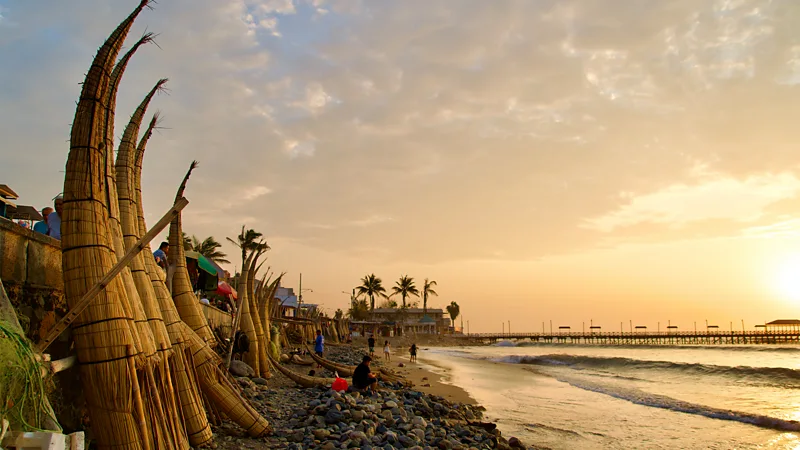The unlikely country that may have invented surfing
For at least 3,500 years, fishermen along the Peruvian coast have been making reed-bound boats and surfing the waves back to shore.

Three-metre-high waves crash onto Playa El Mogote in the northern Peruvian seaside village of Huanchaco. Gazing out into the beach, a mix of locals and international tourists surf in the Pacific, but around a curve in the coastline, the arched prows of caballitos de totora line the beach, their bows pointing towards the ocean. For at least the past 3,500 years, Huanchaco's fishermen have been using these reed crafts to surf.
Known as tup in Mochica, one of Peru's extinct Indigenous languages, or caballitos ("little horses") in Spanish, these ancient crafts are made with tightly tied bundles of totora reeds that grow in freshwater ponds near the coast. Their signature upturned, narrow bow both slices through and pops up over the waves. The Pacific is anything but peaceful here, and in recent years its epic swells have been drawing modern surfers from around the world.
But for those who have lived on this coast for thousands of years, caballitos were the only thing that could punch through the waves to help them reach their fishing areas before letting them surf their way back to the beach. Huanchaceños who still make caballitos are proud of their crafts, which some have claimed are one of the world's earliest surfboards, though every year fewer people here are learning the art of cultivating totora and constructing caballitos. Now, this ancient tradition is at risk of disappearing in the next few decades.
Surfing is commonly believed to have been invented in Hawaii and petroglyphs depicting people riding waves date to at least the 12th Century CE. Yet, the Chan Chan Museum near Huanchaco and the Larco Museum in Lima display ancient ceramics showing people and gods using caballitos to surf, fish and even transport prisoners that predate this.
"Nobody here fishes with a wooden boat," said Carlos Ucañan Arzola, one of Huanchaco's last caballito makers. "Totora is traditional and ancestral, from the Mochicas (also known as the Moche culture dating from the 1st-8th Centuries CE). This totora was preserved in Chan Chan," he added, referring to the 7th-Century Chimú city whose centre is only 5km from Huanchaco. Renowned Peruvian historian María Rostworowski believes these ceramics may date back even earlier to at least 1400 BCE.
Caballitos measure about 4m long, a little under 1m wide and can carry loads up to 100kg. When they're dry, the boats weigh about 40kg, but after a morning fishing, they can weigh twice that and must be set upright on the beach to dry for a day or two.
Today, Huanchaco's roughly 40 remaining fishermen all still use caballitos when they go out to set or check their nets. But as large commercial fishing boats have encroached on the coast, and an increase in erosion and litter often leaves the nets tangled or ripped, fishermen say the trade is becoming less profitable every year. As a result, many Huanchaceños have turned to tourism or left to seek opportunities elsewhere.
"There's only three men in my generation who fish on a caballito," said 30-year-old Edwin Blas Arroyo, who started learning to fish on a caballito from his uncle and grandfather when he was only seven.
But even as more and more young people gravitate from fishing to tourism and away from these ancient surfboards towards modern ones, the caballito remains the symbol of Huanchaco.
"In Huanchaco there is a community that's remarkably proud, conscious of their past, the heritage of their culture and their knowledge, which dates to the times of the Mochicas and the Chimús (12th-16th Centuries), people who were intimately linked to the sea," wrote Marina Quiñe, a professor of marine biology at Lima's Universidad Científica del Sur in her study The caballito de totora in Huanchaco. "Since its origin, fishing with a caballito de totora has been practiced without interruption on the Peruvian coast."
According to Enrique Amayo Zevallos', author of Sea and Waves: Rite and Sport of the Tup or Caballito de Totora to the Modern Surf Board, surfing for sport, competition and ritual was usually done on a craft similar to a tup, called tupe, made with a combination of totora reeds, bamboo and sea lion skins. The rituals lasted up until the Spanish banned them for being pagan. "The purpose of [the tupe] was to have fun cutting through the waves of the sea, or surfing," Amayo Zevallos explained. Today, only the tup, which has historically been used for both surfing and fishing, survives.
Jordi Rivera Prince, an anthropological bioarchaeologist who specialises in ancient Andean coastal fishing communities, noted, "The design of a caballito is virtually unchanged in the past 3,500 years … It's history and living culture at the same time."
Totora reeds are a delicate crop, and cultivating, harvesting and transforming them into seafaring vessels is an art passed down through the generations. Fishermen bind the reeds so their triangular stems fit together perfectly and there are no pockets of air left between them. It takes days to dry the fresh reeds and hours to make all four bundles needed to assemble a new craft. Today, most fishermen tie the totora with nylon cords, though in the past they used thin ropes of braided llama fur. With the wear from heavy waves, strong equatorial sun and abrasion from sand and stones, caballitos don't last more than a couple months, so the cords are saved to make new crafts.
Though primarily used for fishing today, Ucañan Arzola said he doesn't want their recreational purpose to be forgotten. "The caballito de totora is also for sport, for surfing the waves." Ucañan Arzola's father taught him to fish and surf on a caballito, and he's travelled to Australia to represent Huanchaco in a surfing competition, where he surfed on the ancient craft.
Looking at caballitos standing upright on the beach, they appear to be made entirely of totora, just as they always have. But watching a fisherman carry his craft to the water, you may also see that the centre of most caballitos' totora bundles are filled with something else. Some fishermen use discarded plastic bottles and some use Styrofoam, but not because they float better.
As development spreads along the coast, totora ponds are disappearing. With each new crop of hotels, restaurants and surf shops, marshes are filled in and unregulated sprawl takes over. Just north of Huanchaco, the government has set aside a stretch of coast for growing totora, but according to Ucañan Arzola, it's not enough to meet the demand of even a few dozen fishermen.
Each pond is "owned" by a family, who cultivates the totora and cuts the reeds as they mature. It can take several months for totora to grow to full height, so families rotate harvesting the reeds from different ponds. As caballitos wear out, rarely is there enough totora to build a new one when it's needed. So, since the mid-1990s, fishermen have had to use some sort of filler to make up for the totora shortage.
Despite the challenges, the few remaining caballito fishermen in Huanchaco are determined to keep this tradition alive.
"The fact that it's endured for thousands of years blows my mind. Especially in today's current [economic] culture, there's so many reasons to leave home, but they stay in Huanchaco," said Rivera Prince. "It's a deeply specialised knowledge that I have so much respect for."
Today many caballito fishermen are in their 40s and 50s, and when they surf back to the beach while sitting down and steering with their bamboo pole, two or three young men wade into the water to catch the boat and pull it up on the sand. After each fisherman empties his catch from the hollow in the back of the craft onto the sand, one of the younger men will hoist the caballito on his shoulders and carry it up the beach to dry. Fishermen always share their catch with these helpers, and with older men who can no longer fish but who come to the beach in the morning. Fish are distributed to the younger generation in gratitude and to the older generation out of respect.
Fortunately, these reed boats are now being preserved as Huanchaco has developed into a modern surfing destination. As the fishing industry has waned, some caballito-makers have started supplementing their income by offering rides to tourists on their reed boats. Their family members and neighbours are also opening surf shops, teaching the modern sport to visitors.
Tourists riding on caballitos sit in the hollow back of the boat, where nets and fish are usually carried. Facing backwards, they don't see the waves coming until they're drenched. These days, passengers are given lifejackets, though the fishermen never use them. Rides usually last about half an hour and cost around 50 Peruvian soles (£10).
Now, as in the past, Huanchaco's fishermen have never used modern paddles, instead preferring the rounded half of a 2m bamboo pole that their ancestors have used for thousands of years. Honouring their traditions while also embracing tourism may be the caballito's best chance at survival. According to Ucañan Arzola, it will also take motivation from the next generation.
"They have to get up early to go fishing. They have to have the incentive from a very young age. They have to learn so much about growing totora and about mending fishing nets. It all takes time. Many gravitate to surfing on modern surfboards but the caballito is surfing also," he said.
Perhaps if the younger generation can remember the caballito's surfing roots, they may be able to ensure its survival.
-BBC







